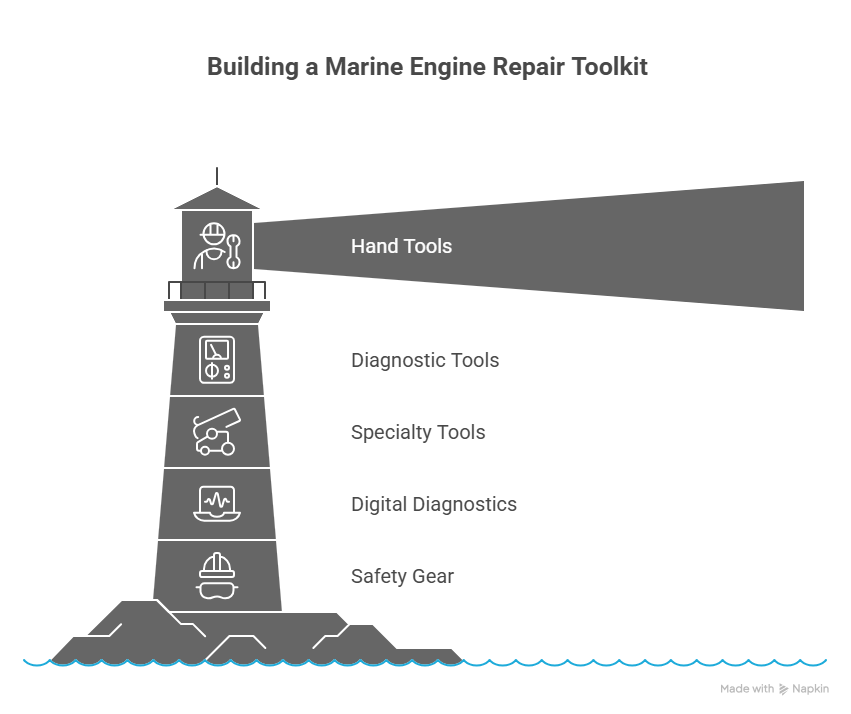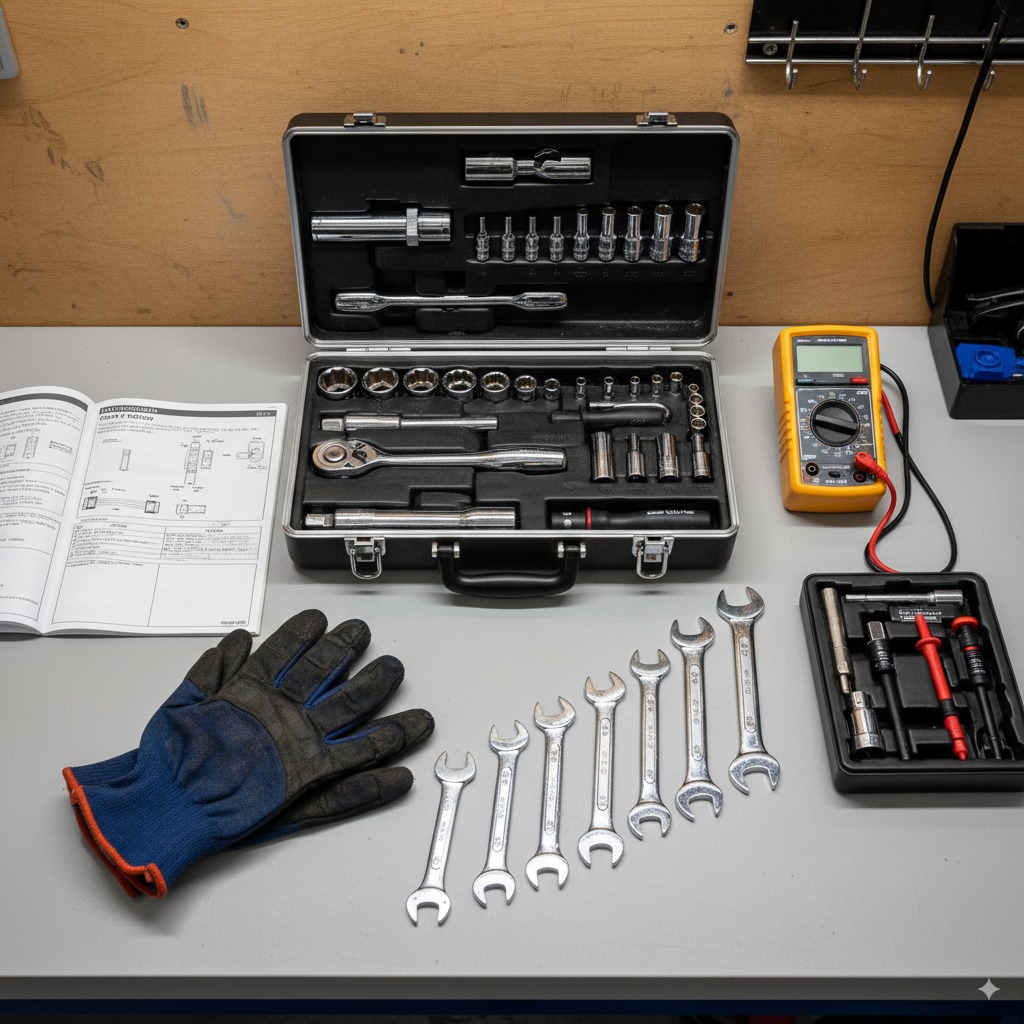Having the Right Tool is Half the Battle
Let me tell you something I’ve learned after 15 years of busting my knuckles on boat motors in South Florida: the right tool isn’t a luxury, it’s everything. It’s the difference between a 20-minute fix that gets you back on the water and a weekend-long nightmare that ends with you calling for a tow.
I’ll never forget a guy named Ray at the Bahia Mar marina. His engine died, and he was sure it was a major problem. He spent hours trying to diagnose it with a cheap automotive test light and a rusty pair of pliers. When I finally got there, I pulled out my multimeter. Five minutes. That’s all it took to find a corroded ground wire. A simple fix, but he couldn’t find it because he didn’t have the right gear. He had tools, but he didn’t have the right tools and equipment for marine engine repair.
This guide isn’t just a list. It’s my philosophy, built from years of experience. We’re going to build your toolkit from the ground up, from the basic hand tools you can’t live without to the diagnostic gear that lets you play detective. Having the right tools and equipment for marine engine repair is about confidence. It’s about knowing you’re ready for whatever the engine throws at you.
Table of Contents
The Foundation: You Gotta Have Good Hand Tools
This is where it all starts. You can have the fanciest diagnostic scanner in the world, but it won’t help you if you can’t turn a bolt.
- Wrenches and Sockets: Don’t cheap out here. Get a good quality set of combination wrenches and a socket set with a solid ratchet. Look for chrome vanadium steel—it resists rust better. You’ll need both metric and imperial (SAE) sizes, because you’ll find a mix of both on many engines.
- Screwdrivers: A good set of Phillips and flathead screwdrivers is non-negotiable. I also keep a long, skinny one for reaching buried hose clamps.
- Pliers: Get a few different types: needle-nose, slip-joint, and a good pair of wire cutters/strippers.
I learned my lesson about cheap hand tools the hard way. I once snapped a cheap wrench trying to break a corroded bolt on a lower unit. My knuckles paid the price. A quality set of hand tools is the foundation of your collection of tools and equipment for marine engine repair.

The Brains: Diagnostic Tools That Save You Money
This is where you go from guessing to knowing. These tools help you understand what your engine is trying to tell you. They are the most critical tools and equipment for marine engine repair when it comes to troubleshooting.
- Digital Multimeter: This is your best friend. It lets you test everything from battery voltage to continuity in a wire. It’s the tool that helped me fix Ray’s engine in five minutes.
- Compression Tester: This tells you the health of your engine’s cylinders. Low compression in one cylinder is a major red flag.
- Spark Tester: A simple, cheap tool that shows you if you’re getting a spark at the plug. No spark? You’ve narrowed your problem down to the ignition system.
- Fuel Pressure Gauge: Essential for fuel-injected engines. It tells you if your fuel pump is doing its job.
The Muscle: Specialty and Lifting Tools
Sooner or later, you’ll need to get into the guts of the engine. That’s when you need the specialty stuff. This category of tools and equipment for marine engine repair is what separates the pros from the amateurs.
- Flywheel Puller: You will not get a flywheel off without one. Don’t even try. You’ll just damage the flywheel.
- Gear Pullers: For pulling bearings, pulleys, and other press-fit parts.
- Lifting Eye and Hoist: If you ever need to pull a powerhead, you need a way to do it safely. A screw-in lifting eye that attaches to the flywheel and an engine hoist are essential.
Here’s a look at how I think about building a toolkit, from the bare essentials to the pro level.
| Tool Category | The Bare Minimum (Weekend Fixes) | The Pro-Level (Serious DIY & Pro) |
|---|---|---|
| Hand Tools | Basic metric/SAE socket set, screwdrivers, pliers | High-quality chrome vanadium sets, torque wrench, breaker bar |
| Diagnostics | Basic multimeter, inline spark tester | Fluke multimeter, compression tester, fuel pressure gauge, timing light |
| Specialty | Prop wrench, filter wrench | Flywheel puller, gear puller set, gasket scraper |
| Safety | Gloves, safety glasses | Nitrile gloves, full-face shield, respirator, fire extinguisher |
Modern Problems, Modern Tools: Digital Diagnostics
For newer engines (like E-TECs, modern four-strokes), the game has changed. These engines are run by computers. That means you need a computer to talk to them. A diagnostic software kit that plugs into your laptop is a powerful piece of tools and equipment for marine engine repair. It lets you read engine error codes, see live data, and even test individual injectors. It’s a significant investment, but for a modern engine, it can save you thousands in diagnostic fees at a dealership.
Don’t Forget Safety: The Most Important Tools of All
All the tools in the world won’t help you if you get hurt. Safety gear is the most important part of your collection of tools and equipment for marine engine repair.
- Gloves: Nitrile gloves will protect your hands from grease and chemicals.
- Eye Protection: Safety glasses are a must. A full-face shield is even better when you’re grinding or using a wire wheel.
- Fire Extinguisher: You are working with fuel. Have a good, fully-charged fire extinguisher within arm’s reach. Always.
FAQ: Questions I Get Asked About Tools
If I can only buy one “expensive” tool, what should it be?
A quality digital multimeter. No question. It will save you more time and money than any other single tool.
How do I stop my tools from rusting in the marine environment?
It’s a constant battle. Store them in a dry toolbox with a desiccant pack. Wipe them down with a light coating of Boeshield T-9 or a similar corrosion inhibitor after each use.
Do I really need a torque wrench?
Yes. Overtightening bolts can warp parts or strip threads. Undertightening can cause leaks or parts to come loose. A torque wrench is essential for any internal engine work.
What’s one cheap tool that’s worth its weight in gold?
A telescoping magnet. When you drop that one critical bolt into the bilge, you’ll thank me.
What’s the biggest mistake people make when buying tools?
Buying cheap, no-name tools. They break, they strip bolts, and they can be dangerous. Buy the best quality you can afford. A good tool is an investment that will last a lifetime. Proper tools and equipment for marine engine repair are worth the money.
So, What’s the Bottom Line?
Building a good collection of tools and equipment for marine engine repair is a journey, not a destination. You don’t need to buy everything at once. Start with a solid foundation of quality hand tools, and then add diagnostic and specialty tools as your skills and needs grow.
Think of your toolbox as your partner. It’s what gives you the confidence to leave the dock, knowing you’re prepared. A well-equipped boater is a safe and self-reliant boater.
Here’s my final advice:
- Start with Quality Basics: A good wrench set will never let you down.
- Learn to Diagnose: Invest in diagnostic tools early. They pay for themselves.
- Organize Your Gear: A clean, organized toolbox makes any job easier.
- Safety Isn’t Optional: Your health is more important than any repair.
Now, go take inventory of your toolkit. What’s missing? Pick one new tool that would make your life easier and add it to your collection. With the right tools and equipment for marine engine repair, you’re not just fixing an engine; you’re buying freedom and peace of mind on the water.
Author Bio
I’m Alex, a 15-year marine technician in South Florida, ABYC-certified. My passion is keeping boats on the water, and that starts with having the right tools. I’ve built my collection of tools and equipment for marine engine repair over thousands of hours working on everything from vintage two-strokes to modern fuel-injected outboards at marinas like Dinner Key and Bahia Mar.


Leave a Reply